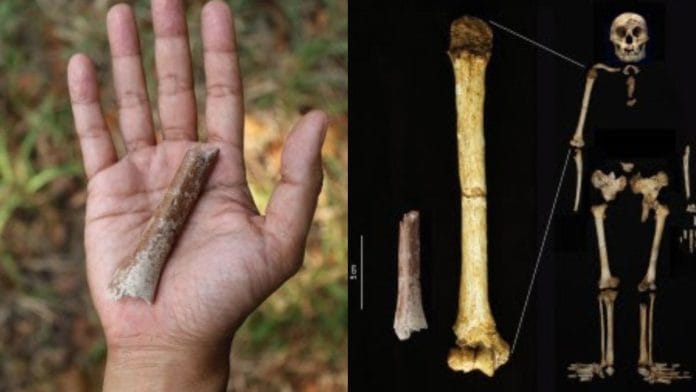New Delhi: A microscopic analysis of a 700,000-year-old miniature human arm and dental fossils has put an end to the debate on the origins of Homo floresiensis — a species of small archaic human that inhabited the Indonesian island of Flores around 60,000 years ago.
The study by researchers from Japan, Indonesia and Australia, published Tuesday in the journal Nature Communications, has found that some early hominins had even smaller body sizes than previously thought. This was done by analysing the fossil remains of the miniature arm and teeth collected from the Mata Menge site on Flores. Hominins are the group of species that includes modern humans, their immediate ancestors and other extinct relatives.
As recorded in previous studies published in October 2004 in Nature, researchers from Australia and Indonesia had discovered Homo floresiensis as a distinct human species after excavating their remains from the limestone caves of Liang Bua on Flores, a remote island in Southeast Asia.
These hominins were nicknamed ‘Hobbits’ as they were only about 106 cm (approximately 3.5 feet) tall.
Human family trees created by the scientific team of the Smithsonian National Museum of Natural History have classified humans into three major groups, namely Ardipithecus, Australopithecus, and the Homo group.
The Homo floresiensis species bear a mix of features both from the ancient Australopithecus and the modern Homo group, thus raising questions about their lineage of descent and reduced body sizes.
The new study offers a deeper understanding of the origin and evolution of the short stature of this Southeast Asian archaic human species.
Also Read: Scientists discover ‘dark oxygen’ produced on deep-ocean floor where the Sun don’t shine
‘Hobbit’ ancestors with shorter limbs
Following the initial discovery of Homo floresiensis in 2004, several other hominin fossil remains were excavated from the Mata Menge site, located east of Liang Bua caves, between 2013 and 2016.
These fossil remains included several teeth, jaw bones and broken fragments of the upper arm, which were both smaller and older than the remains found previously in Liang Bua — and much older. They were dated to 700,000 years ago — more than 600,000 years before the earliest fossil evidence of Homo floresiensis at Liang Bua.
Some of the researchers thought the specimens belonged to a modern human child. However, they were intrigued by the stage of development of these fossils.
“When I first saw the small humerus, I thought it was a child’s bone, but I became curious and was surprised when I looked up its developmental stage,” said Yousuke Kaifu — one of the lead researchers of the study who is affiliated with the University of Tokyo — in a statement to the press.
According to the authors of the study, the size and age estimation of these fossil samples is a tricky process and requires the expertise of several other researchers.
The excavation process from an extremely compact sandstone damaged the upper arm bone into smaller fragments. In 2015, two years after its initial discovery, the specimen was reconstructed in a lab.
In this study, the authors analysed this reconstructed arm to make estimates of the age and length of the individual to whom it belonged. They reported that this fossil arm, with a length of 211-220 mm, was the smallest ever arm for an adult individual with an estimated body height of 100 cm.
The individual would have been around 6 cm shorter than the estimated body height of the type specimen of Homo floresiensis, with arm being over 20-30 mm shorter.
Similarities with large-bodied Javanese Homo
Considering the proximity of the Mata Menge excavation site to the Indonesian island of Java, experts expected the remains of the So’a Basin of the site to bear similarities with the Javanese Homo erectus species, the ancestor of modern humans.
“Initially, we didn’t recognise the humerus (upper arm bone) fragment, which was broken in several pieces, as belonging to a hominin, because we expected that the toolmaker at Mata Menge would be a large-bodied Homo erectus,” said Gerrit van den Bergh of Australia’s University of Wollongong, another author of the study.
“But after painstaking reconstruction by curator Indra Sutisna, the fossil was recognised as a hominin distal humerus fragment and a very small one for that matter,” he added.
Despite the huge similarity in their body size (estimated at 100 cm) with the more primitive Australopithecus (109 to 149 cm) of African origin, they could not be placed within this group, owing to dental differences and lack of recovery of the fossil remains of this primitive group from Indonesia, or indeed the wider region.
Combining this evidence, the researchers estimated that the small stature evolved over 300,000 years, when these small-bodied hominins evolved from Homo erectus between 1 million and 700,000 years ago.
Muskan Bhatia is an intern with ThePrint.
(Edited by Mannat Chugh)
Also Read: Scientists identify Ladakh as potential analogue research site to conduct Moon, Mars mission studies






